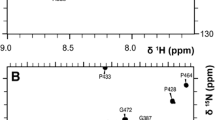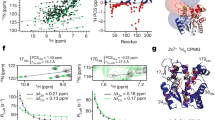Abstract
Traditional single site replacement mutations (in this case, phenylalanine to tyrosine) were compared with methods which exclusively employ 15N and 19F-edited two- and three-dimensional NMR experiments for purposes of assigning 19F NMR resonances from calmodulin (CaM), biosynthetically labeled with 3-fluorophenylalanine (3-FPhe). The global substitution of 3-FPhe for native phenylalanine was tolerated in CaM as evidenced by a comparison of 1H-15N HSQC spectra and calcium binding assays in the presence and absence of 3-FPhe. The 19F NMR spectrum reveals six resolved resonances, one of which integrates to three 3-FPhe species, making for a total of eight fluorophenylalanines. Single phenylalanine to tyrosine mutants of five phenylalanine positions resulted in 19F NMR spectra with significant chemical shift perturbations of the remaining resonances, and provided only a single definitive assignment. Although 1H-19F heteronucleclear NOEs proved weak, 19F-edited 1H-1H NOESY connectivities were relatively easy to establish by making use of the 3JFH coupling between the fluorine nucleus and the adjacent fluorophenylalanine δ proton. 19F-edited NOESY connectivities between the δ protons and α and β nuclei in addition to 15N-edited 1H, 1H NOESY crosspeaks proved sufficient to assign 4 of 8 19F resonances. Controlled cleavage of the protein into two fragments using trypsin, and a repetition of the above 2D and 3D techniques resulted in unambiguous assignments of all 8 19F NMR resonances. Our studies suggest that 19F-edited NOESY NMR spectra are generally adequate for complete assignment without the need to resort to mutational analysis.






Similar content being viewed by others
Abbreviations
- 1D:
-
One-dimensional
- 2D:
-
Two-dimensional
- 3D:
-
Three-dimensional
- CaM:
-
Calmodulin
- CSA:
-
Chemical shift anisotropy
- DNase:
-
Deoxyribonuclease
- RNase:
-
Ribonuclease
- IPTG:
-
Isopropyl β-D-1-thiogalactopyranoside
- EDTA:
-
Ethylenediaminetetraacetic acid
- NMR:
-
Nuclear magnetic resonance
References
Anderluh G, Razpotnik A, Podlesek Z, Macek P, Separovic F, Norton RS (2005) Interaction of the eukaryotic pore-forming cytolysin equinatoxin Ii with model membranes: F-19 Nmr studies. J Mol Biol 347:27–39
Andre I, Linse S (2002) Measurement of Ca2+-binding constants of proteins and presentation of the caligator software. Anal Biochem 305:195–205
Baber JL, Szabo A, Tjandra N (2001) Analysis of slow interdomain motion of macromolecules using NMR relaxation data. J Am Chem Soc 123:3953–3959
Barbato G, Ikura M, Kay LE, Pastor RW, Bax A (1992) Backbone dynamics of calmodulin studied by N-15 relaxation using inverse detected 2-dimensional NMR-spectroscopy—the central helix is flexible. Biochemistry 31:5269–5278
Bertini I, Del Bianco C, Gelis I, Katsaros N, Luchinat C, Parigi G, Peana M, Provenzani A, Zoroddu MA (2004) Experimentally exploring the conformational space sampled by domain reorientation in calmodulin. Proc Natl Acad Sci U S A 101:6841–6846
Brokx RD, Vogel HJ (2002) In: J VH (ed) Calcium-binding proteins protocols. Humana Press Inc., Totawa, pp 183–193
Chambers SE, Lau EY, Gerig JT (1994) Origins of fluorine chemical-shifts in proteins. J Am Chem Soc 116:3603–3604
Crivici A, Ikura M (1995) Molecular and structural basis of target recognition by calmodulin. Annu Rev Biophys Biomol Struct 24:85–116
Danielson MA, Falke JJ (1996) Use of F-19 NMR to probe protein structure and conformational changes. Annu Rev Biophys Biomol Struct 25:163–195
Delaglio F, Grzesiek S, Vuister GW, Zhu G, Pfeifer J, Bax A (1995) Nmrpipe—a multidimensional spectral processing system based on unix pipes. J Biomol NMR 6:277–293
Drabikowski W, Kuznicki J, Grabarek Z (1977) Similarity in Ca-2+-induced changes between troponin-c and protein Activator of 3′=5′-cyclic nucleotide phosphodiesterase and their tryptic fragments. Biochim Biophys Acta 485:124–133
Drake SK, Bourret RB, Luck LA, Simon MI, Falke JJ (1993) Activation of the phosphosignaling protein chey. 1. Analysis of the phosphorylated conformation by F-19 NMR and protein engineering. J Biol Chem 268:13081–13088
Evanics F, Kitevski JL, Bezsonova I, Forman-Kay J, Prosser RS (2007) F-19 NMR studies of solvent exposure and peptide binding to an Sh3 domain. Biochimica Et Biophysica Acta-General Subjects 1770:221–230
Evenas J, Thulin E, Malmendal A, Forsen S, Carlstrom G (1997) Nmr studies of the E140q mutant of the carboxy-terminal domain of calmodulin reveal global conformational exchange in the Ca2+-saturated state. Biochemistry 36:3448–3457
Fallon JL, Quiocho FA (2003) A closed compact structure of native Ca2+-calmodulin. Structure 11:U1303–U1307
Feeney J, McCormick JE, Bauer CJ, Birdsall B, Moody CM, Starkmann BA, Young DW, Francis P, Havlin RH, Arnold WD, Oldfield E (1996) F-19 nuclear magnetic resonance chemical shifts of fluorine containing aliphatic amino acids in proteins: studies on lactobacillus casei dihydrofolate reductase containing (2s, 4s)-5-fluoroleucine. J Am Chem Soc 118:8700–8706
Finn BE, Evenas J, Drakenberg T, Waltho JP, Thulin E, Forsen S (1995) Calcium-induced structural-changes and domain autonomy in calmodulin. Nat Struct Biol 2:777–783
Gakh YG, Gakh AA, Gronenborn AM (2000) Fluorine as an NMR probe for structural studies of chemical and biological systems. Magn Reson Chem 38:551–558
Gerig JT (1994) Fluorine NMR of proteins. Prog Nucl Magn Reson Spectrosc 26:293–370
Harris RK, Becker ED, De Menezes SMC, Goodfellow R, Granger P (2002) NMR nomenclature: nuclear spin properties and conventions for chemical shifts (Iupac Recommendations 2001) (Reprinted from Pure Appl Chem, vol 73, pp 1795–1818, 2001). Concepts Magn Resonance 14:326–346
Hoeflich KP, Ikura M (2002) Calmodulin in action: diversity in target recognition and activation mechanisms. Cell 108:739–742
Ikura M, Marion D, Kay LE, Shih H, Krinks M, Klee CB, Bax A (1990) Heteronuclear 3d NMR and isotopic labeling of calmodulin—towards the complete assignment of the H-1-NMR spectrum. Biochem Pharmacol 40:153–160
Ishida H, Takahashi K, Nakashima K, Kumaki Y, Nakata M, Hikichi K, Yazawa M (2000) Solution structures of the N-terminal domain of yeast calmodulin: Ca2+-dependent conformational change and its functional implication. Biochemistry 39:13660–13668
Johnson BA, Blevins RA (1994) NMR view—a computer-program for the visualization and analysis of NMR data. J Biomol NMR 4:603–614
Khan F, Kuprov I, Craggs TD, Hore PJ, Jackson SE (2006) F-19 NMR studies of the native and denatured states of green fluorescent protein. J Am Chem Soc 128:10729–10737
Kitevski-LeBlanc JL, Al-Abdul-Wahid MS, Prosser RS (2009) A mutagenesis-free approach to assignment of F-19 NMR resonances in biosynthetically labeled proteins. J Am Chem Soc 131:2054-+
Li HL, Frieden C (2007) Observation of sequential steps in the folding of intestinal fatty acid binding protein using a slow folding mutant and F-19 NMR. Proc Natl Acad Sci U S A 104:11993–11998
Linse S, Helmersson A, Forsen S (1991) Calcium-binding to calmodulin and its globular domains. J Biol Chem 266:8050–8054
Loladze VV, Ermolenko DN, Makhatadze GI (2002) Thermodynamic consequences of burial of polar and non-polar amino acid residues in the protein interior. J Mol Biol 320:343–357
Malmendal A, Evenas J, Forsen S, Akke M (1999) Structural dynamics in the C-terminal domain of calmodulin at low calcium levels. J Mol Biol 293:883–899
Meyer DF, Mabuchi Y, Grabarek Z (1996) The role of Phe-92 in the Ca2+-induced conformational transition in the C-terminal domain of calmodulin. J Biol Chem 271:11284–11290
Okano H, Cyert MS, Ohya Y (1998) Importance of phenylalanine residues of yeast calmodulin for target binding and activations. J Biol Chem 273:26375–26382
Phillips L, Separovic F, Cornell BA, Barden JA, Dosremedios CG (1991) Actin dynamics studied by solid-state NMR-spectroscopy. Eur Biophys J 19:147–155
Richards FM (1977) Areas, volumes, packing, and protein-structure. Annu Rev Biophys Bioeng 6:151–176
Rinaldi PL (1983) Heteronuclear 2d-Noe spectroscopy. J Am Chem Soc 105:5167–5168
Torizawa T, Shimizu M, Taoka M, Miyano H, Kainosho M (2004) Efficient production of isotopically labeled proteins by cell-free synthesis: a practical protocol. J Biomol NMR 30:311–325
Walsh M, Stevens FC, Kuznicki J, Drabikowski W (1977) Characterization of tryptic fragments obtained from bovine brain protein modulator of cyclic nucleotide phosphodiesterase. J Biol Chem 252:7440–7443
Willis MA, Bishop B, Regan L, Brunger AT (2000) Dramatic structural and thermodynamic consequences of repacking a protein’s hydrophobic core. Structure 8:1319–1328
Woolfson DN (2001) Core-directed protein design. Curr Opin Struct Biol 11:464–471
Xiao GY, Parsons JF, Tesh K, Armstrong RN, Gilliland GL (1998) Conformational changes in the crystal structure of rat glutathione transferase M1–1 with global substitution of 3-fluorotyrosine for tyrosine. J Mol Biol 281:323–339
Yamazaki T, Formankay JD, Kay LE (1993) 2-dimensional NMR experiments for correlating C-13-Beta and H-1-delta/epsilon chemical-shifts of aromatic residues in C-13-labeled proteins via scalar couplings. J Am Chem Soc 115:11054–11055
Zhang M, Tanaka T, Ikura M (1995) Calcium-induced conformational transition revealed by the solution structure of apo calmodulin. Nat Struct Biol 2:758–767
Acknowledgments
We wish to thank Professor Mitsu Ikura (University of Toronto) for providing the plasmid for Xenopus laevis calmodulin. Michael Bokoch (Stanford University) for the preparation of phenylalanine to tyrosine mutant DNA. We would like to acknowledge Professors Lewis Kay and Julie Forman-Kay (University of Toronto) for helpful comments. Julianne Kitevski-LeBlanc wishes to acknowledge the Natural Sciences and Engineering Research Council of Canada (NSERC) for a doctoral fellowship and RSP acknowledges NSERC and the Canadian Foundation for Innovation (CFI) for financial support through the NSERC discovery program and CFI New Opportunities programs.
Author information
Authors and Affiliations
Corresponding author
Electronic supplementary material
Below is the link to the electronic supplementary material.
Rights and permissions
About this article
Cite this article
Kitevski-LeBlanc, J.L., Evanics, F. & Scott Prosser, R. Approaches to the assignment of 19F resonances from 3-fluorophenylalanine labeled calmodulin using solution state NMR. J Biomol NMR 47, 113–123 (2010). https://doi.org/10.1007/s10858-010-9415-y
Received:
Accepted:
Published:
Issue Date:
DOI: https://doi.org/10.1007/s10858-010-9415-y




